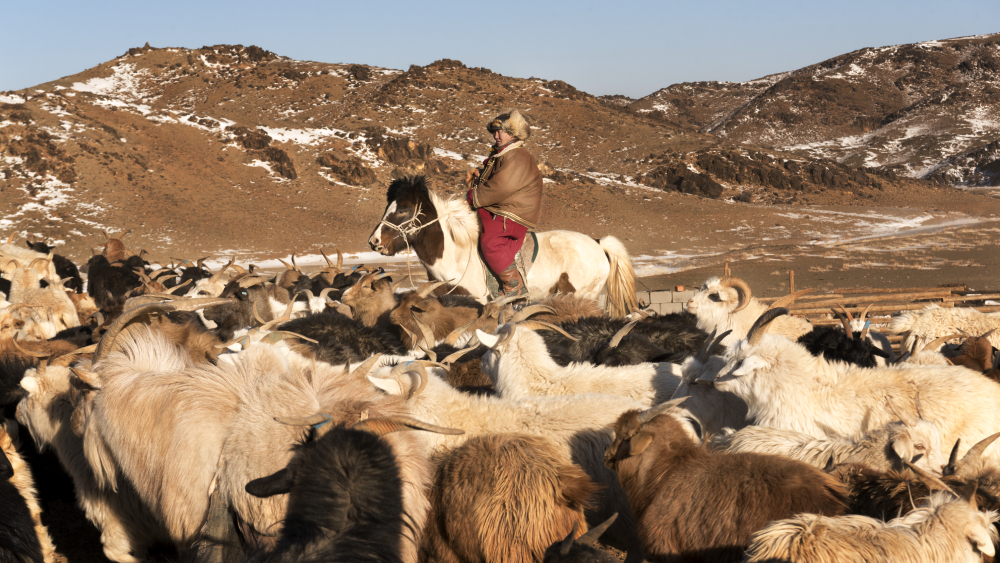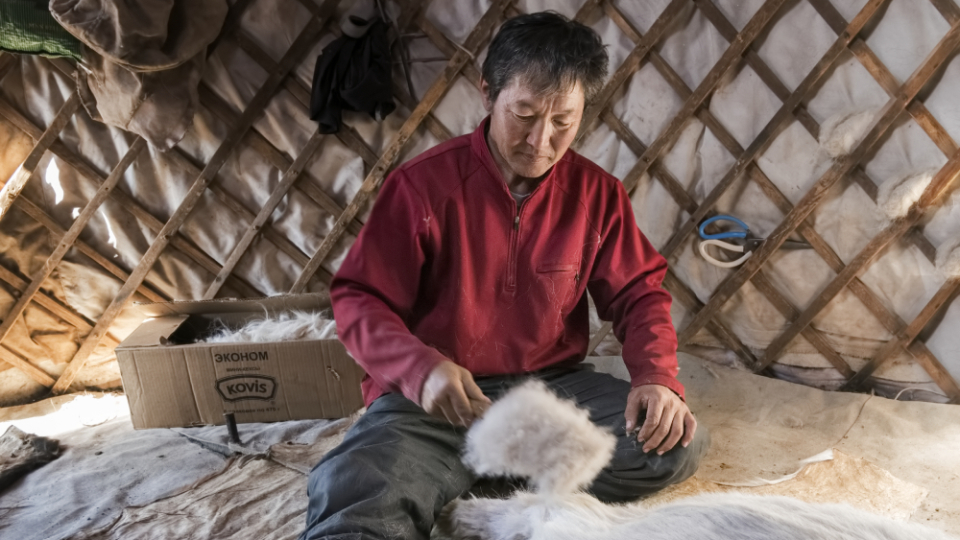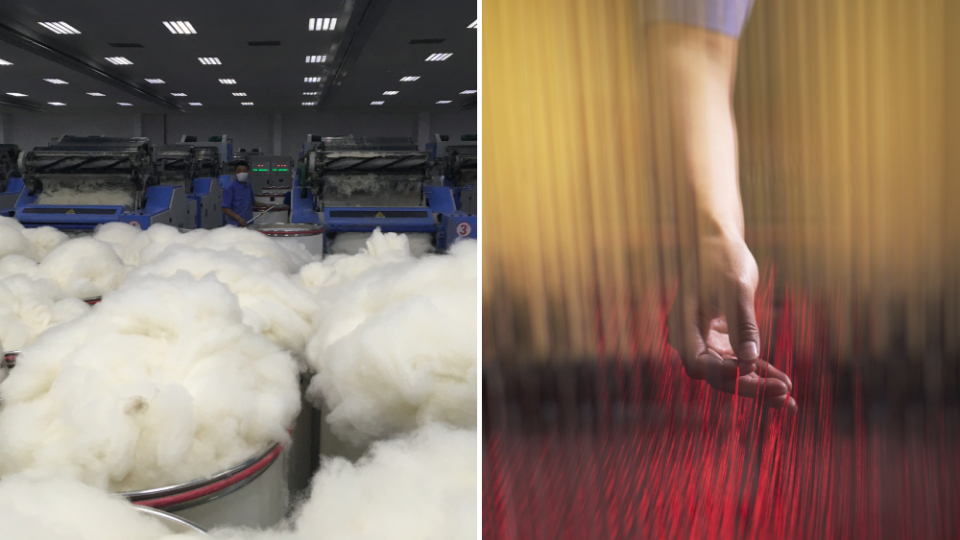
Robb Read: Cashmere In Crisis
The fabric synonymous with luxury is under threat from cross-border bickering, climate change and the global pandemic.
Related articles
Cashmere is an unlikely candidate for controversy. It conjures up images of cosy, expensive scarves, made from the belly hair of goats roaming across the steppes of Mongolia, using techniques and skills honed over the centuries. It’s a luxe treat that has grown more accessible in recent years; check out the availability of cashmere knitwear in various mass-market stores, for example.
Yet even though the price of a cashmere sweater might have dipped, the costs are now higher than ever.
Much like one of the bitter winters, known as dzuds, that menace Mongolia, this age-old industry faces a perfect storm of challenges: rising demand, surging temperatures and plunging prices for raw materials, which should put cashmere into any ethical shopper’s crosshairs.
First, demand. Cashmere forms almost 7 per cent of the approx. $93 billion global luxury industry alone—more a problem than an opportunity when each goat’s yield is a meagre four ounces of finished fibre. Farmers have boosted their flocks to better cater to the new market; some 29 million goats graze the steppes today, almost five times the number 30 years ago. Such an increase in livestock would likely stress even plush pastures thanks to overgrazing, but the land in Mongolia is under its own duress. Ninety percent of the country is drylands and so especially vulnerable to desertification. Mongolia is a hot spot for climate change, where temperatures have risen by 4 degrees since 1940, compared with an average global rise of about 1.5 degrees. Of course, that warming threatens the very ecosystem on which the goats depend—the second major problem.
These two challenges are compounded by the crashing prices for raw cashmere. It was hard enough to ensure fair trade for the herders via the cashmere industry’s rickety supply chain, which yokes family herders to small processing centres and then to foreign mills with little connection to the herders halfway across the world. There’s no way to trace fibres and so make certain that herders received a proper price for the cashmere that is knitted into a $1,000 sweater. Add to that the pressures of the pandemic: after matching all-time highs in 2019, prices for raw cashmere recently plummeted by almost half. Mongolia’s largest processing factory, Gobi Cashmere, has already laid off
10 percent of its staff as a result, and insiders report that many brands have pulled back on purchases, relying on existing stocks rather than buying more wool—and exacerbating the glut.
These are just the issues in Mongolia. Today, there’s an enormous cashmere-producing industry across the border in China, too, and the rival operation there has its own ethical challenges: animal husbandry at the enormous, industrial-style farms, for one thing, as well as the risk of fraud. Two long-term cashmere-industry executives warn of the constant risk of Chinese producers bulking out their fine cashmere with bleached camel hair or extra-fine merino wool. One of the sources calls them “past masters at adulterating fibres”.
Clearly, then, there’s a yearning need for a yarn standard. Think of a Woolmark-style assurance for the cashmere niche guaranteeing a luxury consumer that their ultra-soft sweater hasn’t caused hardship at its source. It’s a conundrum the industry recognises very well. If only businesses were tackling it properly. Instead, rather than companies coordinating efforts, a series of rival programs are jostling for prominence as the de facto soft-gold standard; two are already in operation, and a third is set to launch soon.
The first is run by the UK-based Sustainable Fibre Alliance. Its SFA Cashmere Standard promises adherence to five freedoms, including freedom from discomfort and thirst for the goats. Among its 45 members are Burberry and Johnstons of Elgin, one of Scotland’s foremost mills and supplier to the likes of Brora.
“There’s a code of practice, around grassland management and animal welfare, and herders have to achieve a pass score,” says Simon Cotton, CEO of Johnstons, of the certification, which aims to help improve the quality of the goat hair while allowing grasslands to rebound, among other things. This year, for the first time, 80 tons of raw fibre were produced with SFA certification. Cotton proudly reports that it traded at 10 percent over market price. But the yield is a tiny amount, given that Mongolia’s total annual production capacity is 9,400 tons. It’s not yet possible, either, for a shopper to know whether a given item was made from SFA-verified cashmere, though the group says that member brands will be able to promote certified products—made with a minimum 33 percent of approved fibre—by next year. The nonprofit plans to launch a Woolmark-style hangtag, but for now the program operates only behind the scenes.
Conversely, walk into a Hugo Boss store later this year, and you could pick up a garment touting its production under the Good Cashmere Standard. A separate, rival nonprofit operates this certification—the German-based Aid by Trade Foundation —with a smaller number of partners, including Boss and Lacoste. The process operates at a grassroots level, including sending teams of verifiers into the field firsthand; earlier this year, they quarantined as a precaution during the pandemic so that they could complete their checks on animal-welfare, environmental and social practices in Mongolia.
“Nothing we do is based on charity or donations,” says Tina Stridde, managing director of Aid by Trade. “It’s all about activating the trade or retail sector to raise the bar of sustainable, responsible trade.” Its certification is offered in two tiers, with the premium level including a DNA-tracing system developed with Swiss firm Haelixa. An invisible liquid is sprayed on raw wool at the buying stations, soon after the hair has been combed from the goats; these fibres can then be tracked throughout production.
Yet this system has one major drawback: it operates only among the industrial farms in China, and there are no plans to extend its verification to the countless herders across the border in Mongolia, where cashmere is the top non-mineral export.
To the mêlée add a new, third program, the South Gobi Cashmere Project, or “Goat to Coat”. It’s a team effort from mining conglomerate Rio Tinto, French luxury group Kering and the Wildlife Conservation Society. Kering, the parent company to Gucci, Balenciaga and YSL, among others, has impressive sustainability bona fides, having launched almost a decade ago its EP&L (Environmental Profit & Loss) program to track the eco-impact of its production. In 2016, it even developed an app that shoppers can use to learn the production history of individual items. Initially, Kering pledged to the Sustainable Fibre Alliance but broke away four years ago for what a spokesperson says delicately were “internal strategic reasons”. It found a willing partner for its stand-alone efforts in mining giant Rio Tinto, which helped underwrite the initiative as part of its own program of environmental offsets around its operations, in this case the Oyu Tolgoi copper and gold mine in Mongolia.
Katrina ole-MoiYoi, Kering’s sustainable sourcing specialist, is closely involved with this program, which aims to use high-tech methods to improve the sustainable standards in cashmere, as she explains. Take goat herding, for which it’s harder than ever to find fresh grasslands. The answer, says ole-MoiYoi, lies in part with NASA and Stanford University. The space agency uses satellites to monitor rainfall and weather patterns worldwide; it passes such data on to scientists in California, who can use computer modelling to predict when deluges or droughts might occur. Under the South Gobi initiative, program managers are then equipped with these grazing forecasts and work directly with the herders to move their livestock strategically, keeping the goats fed while also allowing vegetation sufficient time to recover.
But as smart as this program might be, it’s aimed at addressing challenges only in the Mongolian supply chain rather than cashmere as a whole, including China. Kering also says it’s up to the individual brands whether to create customer-facing certifications—say, a “Cashmeremark” —that would guarantee sourcing to a shopper. In the meantime, it’s another corporate scheme to which luxury firms can pledge adherence. As yet, Kering has not confirmed other partners.
Each of these efforts is admirable, of course, but for a consumer, the confusion and challenges are likely to persist.
One luxury executive says that an industry-wide benchmark is almost impossible to establish, owing in part to rivalry between the two main cashmere-producing nations, Mongolia and China, locked in a long-standing tussle to establish primacy. In truth, they are separate but equal: China’s fibres are often white, but can be finer and so less strong, while Mongolia often produces flexible, durable hair that tends to be grey, cream or brown in colour. Chinese authorities, then, would adopt an industry-wide benchmark on one condition: if its parameters skewed so as to establish, permanently, that Chinese cashmere was better.
But locals doubt that even a program aimed only at Mongolia, where the problems are more acute, can easily succeed. Ulziibodijav Jambal, known as Bodio, lives in Ulaanbaatar and owns a knitwear and dehairing facility. He notes that many of the workers in such programs are shipped in from overseas.
“It is nearly impossible to have a clear understanding of this very unique community of people unless you are born and raised among them,” he tells Robb Report. “Most projects usually involve more international marketing expertise than local experts who can relate them to herders’ lives. This leads to a false impression of what they can achieve but without having proper understanding of the root of the problem they need to face.”
Take, for example, asking herders to decrease the number of animals in their flocks and so, in theory, boost the price of cashmere. It won’t work, as China has an effective monopoly on pricing, buying 80 percent of the raw wool from Mongolia to process into yarn in its factories. Put another way, it’s China, rather than the law of supply and demand, that determines what herders earn per gram.
Until there’s a clear, industry-wide solution, then, perhaps it’s best to look elsewhere. Wendy Pieh lives in Bremen, Maine, and runs the Cashmere Goat Association. Her small herd of goats is among the 10,000 or so animals farmed Stateside. They develop their warm, thick coats as a result of the brutal New England winters, and Pieh sells small-batch fibre and yarn to niche customers, both amateur knitters and professional designers, including Jeffrey Monteiro of J.M. Generals. Her product is a guilt-free luxury. It’s local, traceable and sustainably farmed on land that isn’t overgrazed. And it’s very expensive, as she explains, quietly proud. “You can buy Mongolian cashmere online for half what I sell it for.”
This piece is from our new Autumn Issue – on sale now. Get your copy or subscribe here, or stay up to speed with the Robb Report weekly newsletter.
Subscribe to the Newsletter
Recommended for you
6 Movies That All Style-Obsessed Guys Should Watch, From ‘Miami Vice’ to ‘After Hours’
Style writer David Coggins on Hollywood’s best under-the-radar menswear inspirations.
May 1, 2024
Shifting into Neutral This Season
How to Rock a Neutral Selection of Menswear This Autumn.
By Zeb Daemen
April 22, 2024
You may also like.
You may also like.
Best fo Europe: Six Senses, Switzerland
Mend in the mountains at Crans-Montana.
Wellness pioneer Six Senses made a name for itself with tranquil, mostly tropical destinations. Now, its first alpine hotel recreates that signature mix of sustainable luxury and innovative spa therapeutics in a world-class ski setting.
The ski-in, ski-out location above the gondola of one of Switzerland’s largest winter sports resorts allows guests to schuss from the top of the Plaine Morte glacier to the hotel’s piste-side lounge, where they can swap ski gear for slippers, then head straight to the spa’s bio-hack recovery area to recharge with compression boots, binaural beats and an herb-spiked mocktail. In summer, the region is a golf and hiking hub.

The vibe offers a contemporary take on chalet style. The 78 rooms and suites are decorated in local larch and oak, and all have terraces or balconies with alpine views over the likes of the Matterhorn and Mont Blanc. With four different saunas, a sensory flotation pod, two pools
and a whimsical relaxation area complete with 15,000 hanging “icicles” and views of a birch forest, the spa at Six Senses Crans-Montana makes après ski an afterthought.
You can even sidestep the cheese-heavy cuisine of this region in favour of hot pots and sushi at the property’s Japanese restaurant, Byakko. Doubles from around $1,205; Sixsenses.com
You may also like.
Best of Europe: Grand Hotel Des Étrangers
Fall for a Baroque beauty in Syracuse, Italy.
Sicily has seen a White Lotus–fuelled surge in bookings for this summer—a pop-culture fillip to fill up its grandes dames hotels. Skip the gawping crowds at the headline-grabbers, though, and opt instead for an insider-ish alternative: the Grand Hotel des Étrangers, which reopened last summer after a gut renovation.
It sits on the seafront on the tiny island of Ortigia in Syracuse, all cobbled streets and grand buildings, like a Baroque time capsule on Sicily’s southeastern coast.
Survey the entire streetscape here from the all-day rooftop bar-restaurant, Clou, where the fusion menu is a shorthand of Sicily’s pan-Mediterranean history; try the spaghetti with bottarga and wild fennel or the sea bass crusted in anchovies. Idle on the terrace alfresco with a snifter of avola, the rum made nearby.

As for the rooms, they’ve been renovated with Art Deco–inflected interiors—think plenty of parquet and marble—but the main asset is their aspect: the best of them have private balconies and a palm tree-fringed view out over the Ionian Sea. Doubles from around $665; desetranger.com
You may also like.
Watch of the Week: TAG Heuer Formula 1 | Kith
The legendary sports watch returns, but with an unexpected twist.
Over the last few years, watch pundits have predicted the return of the eccentric TAG Heuer Formula 1, in some shape or form. It was all but confirmed when TAG Heuer’s heritage director, Nicholas Biebuyck, teased a slew of vintage models on his Instagram account in the aftermath of last year’s Watches & Wonders 2023 in Geneva. And when speaking with Frédéric Arnault at last year’s trade fair, the former CEO asked me directly if the brand were to relaunch its legacy Formula 1 collection, loved by collectors globally, how should they go about it?
My answer to the baited entreaty definitely didn’t mention a collaboration with Ronnie Fieg of Kith, one of the world’s biggest streetwear fashion labels. Still, here we are: the TAG Heuer Formula 1 is officially back and as colourful as ever.
As the watch industry enters its hype era—in recent years, we’ve seen MoonSwatches, Scuba Fifty Fathoms, and John Mayer G-Shocks—the new Formula 1 x Kith collaboration might be the coolest yet.

Here’s the lowdown: overnight, TAG Heuer, together with Kith, took to socials to unveil a special, limited-edition collection of Formula 1 timepieces, inspired by the original collection from the 1980s. There are 10 new watches, all limited, with some designed on a stainless steel bracelet and some on an upgraded rubber strap; both options nod to the originals.
Seven are exclusive to Kith and its global stores (New York, Los Angeles, Miami, Hawaii, Tokyo, Toronto, and Paris, to be specific), and are made in an abundance of colours. Two are exclusive to TAG Heuer; and one is “shared” between TAG Heuer and Kith—this is a highlight of the collection, in our opinion. A faithful play on the original composite quartz watch from 1986, this model, limited to just 1,350 pieces globally, features the classic black bezel with red accents, a stainless steel bracelet, and that creamy eggshell dial, in all of its vintage-inspired glory. There’s no doubt that this particular model will present as pure nostalgia for those old enough to remember when the original TAG Heuer Formula 1 made its debut.

Of course, throughout the collection, Fieg’s design cues are punctuated: the “TAG” is replaced with “Kith,” forming a contentious new brand name for this specific release, as well as Kith’s slogan, “Just Us.”
Collectors and purists alike will appreciate the dedication to the original Formula 1 collection: features like the 35mm Arnite cases—sourced from the original 80s-era supplier—the form hour hand, a triangle with a dot inside at 12 o’clock, indices that alternate every quarter between shields and dots, and a contrasting minuterie, are all welcomed design specs that make this collaboration so great.
Every TAG Heuer Formula 1 | Kith timepiece will be presented in an eye-catching box that complements the fun and colour theme of Formula 1 but drives home the premium status of this collaboration. On that note, at $2,200 a piece, this isn’t exactly an approachable quartz watch but reflects the exclusive nature of Fieg’s Kith brand and the pieces he designs (largely limited-edition).

So, what do we think? It’s important not to understate the significance of the arrival of the TAG Heuer Formula 1 in 1986, in what would prove integral in setting up the brand for success throughout the 90’s—it was the very first watch collection to have “TAG Heuer” branding, after all—but also in helping to establish a new generation of watch consumer. Like Fieg, many millennial enthusiasts will recall their sentimental ties with the Formula 1, often their first timepiece in their horological journey.
This is as faithful of a reissue as we’ll get from TAG Heuer right now, and budding watch fans should be pleased with the result. To TAG Heuer’s credit, a great deal of research has gone into perfecting and replicating this iconic collection’s proportions, materials, and aesthetic for the modern-day consumer. Sure, it would have been nice to see a full lume dial, a distinguishing feature on some of the original pieces—why this wasn’t done is lost on me—and perhaps a more approachable price point, but there’s no doubt these will become an instant hit in the days to come.
—
The TAG Heuer Formula 1 | Kith collection will be available on Friday, May 3rd, exclusively in-store at select TAG Heuer and Kith locations in Miami, and available starting Monday, May 6th, at select TAG Heuer boutiques, all Kith shops, and online at Kith.com. To see the full collection, visit tagheuer.com
You may also like.
06/05/2024
30/04/2024
06/05/2024
8 Fascinating Facts You Didn’t Know About Aston Martin
The British sports car company is most famous as the vehicle of choice for James Bond, but Aston Martin has an interesting history beyond 007.
Aston Martin will forever be associated with James Bond, ever since everyone’s favourite spy took delivery of his signature silver DB5 in the 1964 film Goldfinger. But there’s a lot more to the history of this famed British sports car brand beyond its association with the fictional British Secret Service agent.
Let’s dive into the long and colourful history of Aston Martin.
You may also like.
What Venice’s New Tourist Tax Means for Your Next Trip
The Italian city will now charge visitors an entry fee during peak season.
Visiting the Floating City just got a bit more expensive.
Venice is officially the first metropolis in the world to start implementing a day-trip fee in an effort to help the Italian hot spot combat overtourism during peak season, The Associated Press reported. The new program, which went into effect, requires travellers to cough up roughly €5 (about $AUD8.50) per person before they can explore the city’s canals and historic sites. Back in January, Venice also announced that starting in June, it would cap the size of tourist groups to 25 people and prohibit loudspeakers in the city centre and the islands of Murano, Burano, and Torcello.
“We need to find a new balance between the tourists and residents,’ Simone Venturini, the city’s top tourism official, told AP News. “We need to safeguard the spaces of the residents, of course, and we need to discourage the arrival of day-trippers on some particular days.”
During this trial phase, the fee only applies to the 29 days deemed the busiest—between April 25 and July 14—and tickets will remain valid from 8:30 am to 4 pm. Visitors under 14 years of age will be allowed in free of charge in addition to guests with hotel reservations. However, the latter must apply online beforehand to request an exemption. Day-trippers can also pre-pay for tickets online via the city’s official tourism site or snap them up in person at the Santa Lucia train station.
“With courage and great humility, we are introducing this system because we want to give a future to Venice and leave this heritage of humanity to future generations,” Venice Mayor Luigi Brugnaro said in a statement on X (formerly known as Twitter) regarding the city’s much-talked-about entry fee.
Despite the mayor’s backing, it’s apparent that residents weren’t totally pleased with the program. The regulation led to protests and riots outside of the train station, The Independent reported. “We are against this measure because it will do nothing to stop overtourism,” resident Cristina Romieri told the outlet. “Moreover, it is such a complex regulation with so many exceptions that it will also be difficult to enforce it.”
While Venice is the first city to carry out the new day-tripper fee, several other European locales have introduced or raised tourist taxes to fend off large crowds and boost the local economy. Most recently, Barcelona increased its city-wide tourist tax. Similarly, you’ll have to pay an extra “climate crisis resilience” tax if you plan on visiting Greece that will fund the country’s disaster recovery projects.





























